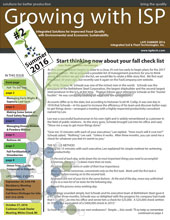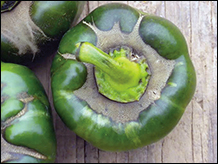

Broad Mites have recently become more of a problem on tomatoes, and peppers on Mid-Atlantic Farms. Damage by Broad Mites can be quite severe on tomatoes and peppers, so growers need to be prepared to protect crops with an effective miticide prior to this pest causing economic losses (see photo below).
Due to their extremely small size (too small to see with the naked eye, or even a 10X hand lens) and the challenges in scouting, I recommend an application of a miticide that is specifically for control of Broad Mites at the formation of the first flowers and a second application in 4 weeks. By the time damage is observed, it is far too late to react. Even an earlier timing is warranted if Broad Mites have been a problem in past production. Growers with damage will sustain high economic losses by the time damage is visual. Inspection of transplants in greenhouse peppers has regularly revealed plants with Broad Mite feeding damage. Therefore, pepper and tomato plants may require miticide applications for Broad Mites as early as the seedling stage. Another distinction with Broad Mites, is plants with spider mites can recover unless their populations are allowed to go unchecked. However, Broad Mite damaged plants are often permanently stunted and may never fully recover.
 The difficulty in minimizing damage is due to the extreme difficulty in scouting for them. It’s not just their very small size, but where they feed. Unlike spider mites that can readily be seen without a hand lens, and are associated with feeding on the bottom of leaves, Broad Mites feed within growing meristems and require dissection of the growing points under a microscope to identify. It is not unusual to see fruit that is damaged and the typical twisted and distorted leaves that their feeding points leave behind, but not be able to isolate them in growing points.
The difficulty in minimizing damage is due to the extreme difficulty in scouting for them. It’s not just their very small size, but where they feed. Unlike spider mites that can readily be seen without a hand lens, and are associated with feeding on the bottom of leaves, Broad Mites feed within growing meristems and require dissection of the growing points under a microscope to identify. It is not unusual to see fruit that is damaged and the typical twisted and distorted leaves that their feeding points leave behind, but not be able to isolate them in growing points.

Materials for Broad Mites (not all miticides are effective on Broad Mites)
- Oberon: The rate for Oberon is 7-8.5 ounce/acre and allows for up to 3 applications per season. The PHI is one day on tomatoes and peppers. Since Oberon has an IRAC code of 23 and Portal is 21A, this could be a good material to rotate to in order to prevent pesticide resistance.
- Portal: Recommended use rates are 2 pints/acre using a minimum of 20 gallons of water per acre. The Maximum use per acre per crop cycle is 4 pints, and the preharvest interval for Portal applications is 1-day. The use of a non-ionic surfactant is recommended.
- Zeal: Zeal is registered for Spider Mites in PA, but has a special needs label in Florida for Broad Mites. With an IRAC code of 10B, Zeal could be important in managing resistance. Since Spider Mites are a consistent irritant in tunnels, by managing Spider mites you also get Broad Mite control. The rate is 2-3 ounce/acre with a 7 day PHI.
- Met 52: Growers in California have found Met 52 to be an effective biological control for Broad Mites. The label rate is 8-64 ounce/acre with a zero day PHI. This fungus-based material will probably be difficult to find in 2016, but should re-emerge in 2017 under new name(s) and with broader labels.
- Grandevo: Work in Florida demonstarated efficacy in using this biological for Broad Mites. The rate is 2-3 pounds/acre with a zero day PHI.
- Venerate: This newest product from Marrone Bio Innovations has also demonstrated Broad Mite control. The rate is 4-8 quarts/acre with a zero day PHI.
Due to their small size and where they feed the use of spray equipment with high pressure and very fine droplet size is highly recommended. Don’t wait until you see ‘alligatored’ fruit to begin management.
